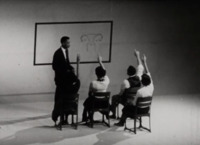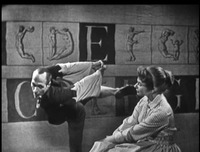Browse Exhibits (2 total)
People are Taught to be Different

12 programs, 1958, KUHT (Houston)
This groundbreaking series uses an all-black cast from the University of Houston to illustrate sociological concepts via dance.
From WNET:
"People are Taught to be Different is a series of films representing a new departure in educational telecasting. From anthropology, social psychology and sociology, it draws case materials that dramatically portray the different ways children are brought up and personality is shaped throughout the world. Against a stylized background of primitive village and modern American life, folkways of childbirth, child-rearing, puberty rituals, courtship behavior, marriage rituals, institutional development, religion, medicine and death rituals are interpreted through the medium of modern dance. The sets, dances and music, create specifically to complement the explanations of the various groups and topics, combine to give, the viewer a “you are there” perspective. The material is presented by Dr. Henry Allen Bullock, professor of sociology and Chairman of the Graduate Research at Texas Southern University. He explains how and why human beings are made into different kinds of persons in different parts of the world."
A Time to Dance

9 episodes, 1960, WGBH (Boston)
From WNET:
"A TIME TO DANCE is a series of nine programs which serve to introduce the audience to the three major dance forms – modern, ballet, and ethnic. Hostess-commentator Martha Myers and a distinguished group of dancers explain and illustrate the differences between each form, their special qualities and traditions, and their relations to each other through common sources. The dancers and Miss Myers perform excerpts from noteworthy dances, and discuss different attitudes towards the life and work of a dancer. In addition to performances by such well-known dancers as a Maria Tallchief, Andre Eglevsky, Jose Limon, Nora Kaye and Geoffrey Holder, Miss Myers uses early prints and unusual films of earlier artists such as Anna Pavlova and Ruth St. Denis to trace the changing look of dance."

